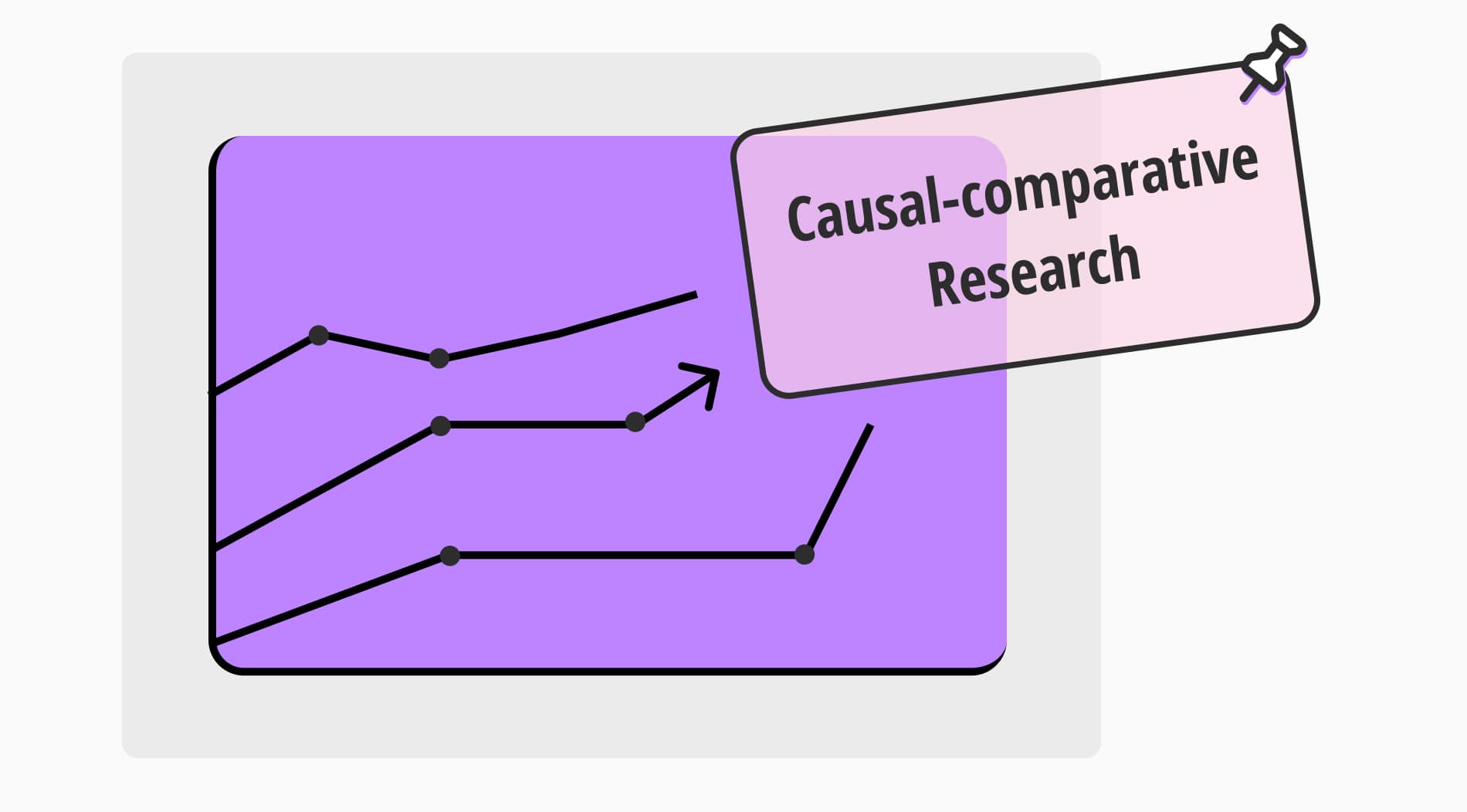Like most of the population in the world, you probably also learned about World War 1 and its short-term and long-term causes. But there was no declaration from the nations stating their reasons. The researchers analyzed the events and occasions and drew cause-and-effect relationships between variables. Thanks to their efforts, the main causes and starting points are clearly defined.
The research method used when investigating the reasons for WWI is causal-comparative research. And in this article, we give an explanation for causal-comparative research, the types of methods, advantages and disadvantages, and examples. Let us get started with the definition!
What is causal-comparative research?
Causal comparative research is a type of research method where the researcher tries to find out if there is a causal effect relationship between dependent and independent variables. In other words, the researcher using this method wants to know whether one thing changing affects another thing, and if so, why.
The researcher can look at previous events and try to draw conclusions and cause-and-effect relationships. But of course, there may be some times when it is not possible to do so. Then, they can collect information about a group of participants and observe the changes in the long run. Let us get into detail on the types of causal-comparative research:
Types of causal-comparative research

Causal-comparative research types
Even though the main objective of a causal-comparative study is to draw cause-and-effect relationships, how the researcher does it may change. Because it is possible that there may be some limitations that put the study in a difficult situation. Mainly, causal-comparative research design is divided into two groups. These research designs are:
1 - Retrospective comparative research
Retrospective comparative study is about the study and comparison of the existing data to know more about the relations, patterns, or outcomes of past events and historical periods. In this study approach, the scientists collect data on past events and try to find results and create patterns. This method is mainly used when it is impossible to do a prospective comparative study. The reasons for limitation can be practical, ethical, or logistical reasons.
2 - Prospective comparative research
The prospective comparative study is about collecting information from a group of participants over a long period. Afterward, the scientists make some predictions about the future. Then, researchers follow the participants and observe the changes, outcomes, or developments. The main goal of this study is to see how the conditions in the beginning change and effect each other.
Causal-comparative research examples
The nature of causal-comparative study design makes it possible to study and make a hypothesis on all kinds of past events and occurrences. When there are multiple variables, researchers can try to make sense of how different variables affect the outcome of situations. Now let us see some causal-comparative study method examples:
Causal-comparative research example #1
For example, let’s imagine that a researcher wants to figure out whether classroom sizes affect students' exam results. In this case, the classroom size is the independent variable, and the effect on academic performance is the dependent variable. The researcher can compare the exam results of students from classes of varying sizes to see if there is a correlation between the two.
Causal-comparative research example #2
There may or may not be a difference in leadership styles between men and women, and it is possible to figure out the difference by looking at various examples. To find data on the subject, the researcher can collect data on the leadership methods from both female and male leaders. And they compare the information between the two groups.
Advantages and disadvantages of causal-comparative research
A causal-comparative study design may be the perfect method for a researcher, but it may not be as suitable for another one. It is up to the aim of the study and the researcher’s wishes to use which research method. In order to make a conscious decision, the researcher should be aware of the advantages and disadvantages of causal-comparative design.
Advantages of causal-comparative research
- This type of study helps identify the causes of occurrences.
- It is useful when experimentation is not possible.
- As this research type relies on existing data or natural occurrences, there is no need for experimentation. Therefore, it is cost-effective.
- The findings of a causal-comparative research study are good for creating a hypothesis.
- It is an effective method to make sense of past events to be prepared for the future.
Disadvantages of causal-comparative research
- Randomization aspect is not possible in this type of study.
- There is a lack of control over independent variables.
- As with other research methodologies, this type of research is also prone to researcher bias. Subject-selection bias may be unavoidable.
- When preexisting characteristics and events are studied, ethical issues may arise, especially if the data is sensitive.
Frequently asked questions about causal-comparative research
Causal-comparative research is mostly a quantitative study, as it gives factual and numerical data. After all, the primary goal of causal-comparative research is to find out whether or not there is a statistically noticeable difference or relation between conditions based on naturally occurring independent variables. But this study method also provides qualitative data as it answers “why” questions.
The main difference between causal-comparative research and correlational research is the fact that causal-comparative research studies two or more groups and one independent variable. And correlational research observes and studies two or more variables and one group.
The difference between experimental and causal-comparative study design is a big one. In the experimental study, the participants are randomly selected. In the causal-comparative study design, however, the participants are already in different groups as the events have already happened. Also, in other instances, natural events are studied without human intervention.
Both causal-comparative studies and quasi-experimental studies are used to explore and identify cause-and-effect relationships, and both of them are non-experimental methods. Causal-comparative research design aims to find causal connections between groups based on naturally occurring independent factors. And quasi-experimental research has a more experimental element, such as partial control over subjects and the use of groups for comparison.
The best sample size for causal-comparative research depends on a number of factors, such as the purpose of the research, research design, and practical limitations. There is no right or wrong sample size for data collection by causal-comparative study. It can change according to the nature of the study.
As much as it is an effective method to create a cause-and-effect relationship between variables, comparative research also has its limits. For example, to name a few, randomization can not be done, and there is a lack of control over independent variables.
Final words
There are times when experimentation can be used, and there are times when it is not possible for ethical or practical reasons. In that case, analyzing events and groups of people is a good way to define the cause-and-effect relationship between two different variables. The researcher can look into the details of past events to draw conclusions, or they can find a defined group to observe and study them long-term.
In this article, we have gathered information on causal-comparative research to give a good idea of the research method. For further information on different research types and for all your research needs, don’t forget to visit our other articles!
Defne is a content writer at forms.app. She is also a translator specializing in literary translation. Defne loves reading, writing, and translating professionally and as a hobby. Her expertise lies in survey research, research methodologies, content writing, and translation.



